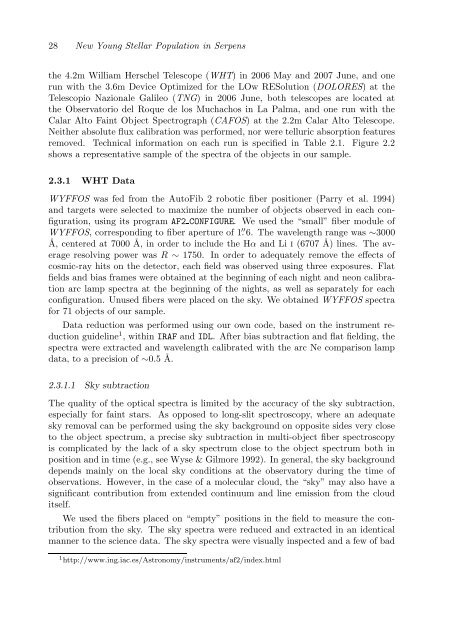Observational Constraints on The Evolution of Dust in ...
Observational Constraints on The Evolution of Dust in ...
Observational Constraints on The Evolution of Dust in ...
Create successful ePaper yourself
Turn your PDF publications into a flip-book with our unique Google optimized e-Paper software.
28 New Young Stellar Populati<strong>on</strong> <strong>in</strong> Serpens<br />
the 4.2m William Herschel Telescope (WHT) <strong>in</strong> 2006 May and 2007 June, and <strong>on</strong>e<br />
run with the 3.6m Device Optimized for the LOw RESoluti<strong>on</strong> (DOLORES) at the<br />
Telescopio Nazi<strong>on</strong>ale Galileo (TNG) <strong>in</strong> 2006 June, both telescopes are located at<br />
the Observatorio del Roque de los Muchachos <strong>in</strong> La Palma, and <strong>on</strong>e run with the<br />
Calar Alto Fa<strong>in</strong>t Object Spectrograph (CAFOS) at the 2.2m Calar Alto Telescope.<br />
Neither absolute flux calibrati<strong>on</strong> was performed, nor were telluric absorpti<strong>on</strong> features<br />
removed. Technical <strong>in</strong>formati<strong>on</strong> <strong>on</strong> each run is specified <strong>in</strong> Table 2.1. Figure 2.2<br />
shows a representative sample <strong>of</strong> the spectra <strong>of</strong> the objects <strong>in</strong> our sample.<br />
2.3.1 WHT Data<br />
WYFFOS was fed from the AutoFib 2 robotic fiber positi<strong>on</strong>er (Parry et al. 1994)<br />
and targets were selected to maximize the number <strong>of</strong> objects observed <strong>in</strong> each c<strong>on</strong>figurati<strong>on</strong>,<br />
us<strong>in</strong>g its program AF2 CONFIGURE. We used the “small” fiber module <strong>of</strong><br />
WYFFOS, corresp<strong>on</strong>d<strong>in</strong>g to fiber aperture <strong>of</strong> 1. ′′ 6. <strong>The</strong> wavelength range was ∼3000<br />
Å, centered at 7000 Å, <strong>in</strong> order to <strong>in</strong>clude the Hα and Li i (6707 Å) l<strong>in</strong>es. <strong>The</strong> average<br />
resolv<strong>in</strong>g power was R ∼ 1750. In order to adequately remove the effects <strong>of</strong><br />
cosmic-ray hits <strong>on</strong> the detector, each field was observed us<strong>in</strong>g three exposures. Flat<br />
fields and bias frames were obta<strong>in</strong>ed at the beg<strong>in</strong>n<strong>in</strong>g <strong>of</strong> each night and ne<strong>on</strong> calibrati<strong>on</strong><br />
arc lamp spectra at the beg<strong>in</strong>n<strong>in</strong>g <strong>of</strong> the nights, as well as separately for each<br />
c<strong>on</strong>figurati<strong>on</strong>. Unused fibers were placed <strong>on</strong> the sky. We obta<strong>in</strong>ed WYFFOS spectra<br />
for 71 objects <strong>of</strong> our sample.<br />
Data reducti<strong>on</strong> was performed us<strong>in</strong>g our own code, based <strong>on</strong> the <strong>in</strong>strument reducti<strong>on</strong><br />
guidel<strong>in</strong>e 1 , with<strong>in</strong> IRAF and IDL. After bias subtracti<strong>on</strong> and flat field<strong>in</strong>g, the<br />
spectra were extracted and wavelength calibrated with the arc Ne comparis<strong>on</strong> lamp<br />
data, to a precisi<strong>on</strong> <strong>of</strong> ∼0.5 Å.<br />
2.3.1.1 Sky subtracti<strong>on</strong><br />
<strong>The</strong> quality <strong>of</strong> the optical spectra is limited by the accuracy <strong>of</strong> the sky subtracti<strong>on</strong>,<br />
especially for fa<strong>in</strong>t stars. As opposed to l<strong>on</strong>g-slit spectroscopy, where an adequate<br />
sky removal can be performed us<strong>in</strong>g the sky background <strong>on</strong> opposite sides very close<br />
to the object spectrum, a precise sky subtracti<strong>on</strong> <strong>in</strong> multi-object fiber spectroscopy<br />
is complicated by the lack <strong>of</strong> a sky spectrum close to the object spectrum both <strong>in</strong><br />
positi<strong>on</strong> and <strong>in</strong> time (e.g., see Wyse & Gilmore 1992). In general, the sky background<br />
depends ma<strong>in</strong>ly <strong>on</strong> the local sky c<strong>on</strong>diti<strong>on</strong>s at the observatory dur<strong>in</strong>g the time <strong>of</strong><br />
observati<strong>on</strong>s. However, <strong>in</strong> the case <strong>of</strong> a molecular cloud, the “sky” may also have a<br />
significant c<strong>on</strong>tributi<strong>on</strong> from extended c<strong>on</strong>t<strong>in</strong>uum and l<strong>in</strong>e emissi<strong>on</strong> from the cloud<br />
itself.<br />
We used the fibers placed <strong>on</strong> “empty” positi<strong>on</strong>s <strong>in</strong> the field to measure the c<strong>on</strong>tributi<strong>on</strong><br />
from the sky. <strong>The</strong> sky spectra were reduced and extracted <strong>in</strong> an identical<br />
manner to the science data. <strong>The</strong> sky spectra were visually <strong>in</strong>spected and a few <strong>of</strong> bad<br />
1 http://www.<strong>in</strong>g.iac.es/Astr<strong>on</strong>omy/<strong>in</strong>struments/af2/<strong>in</strong>dex.html
















